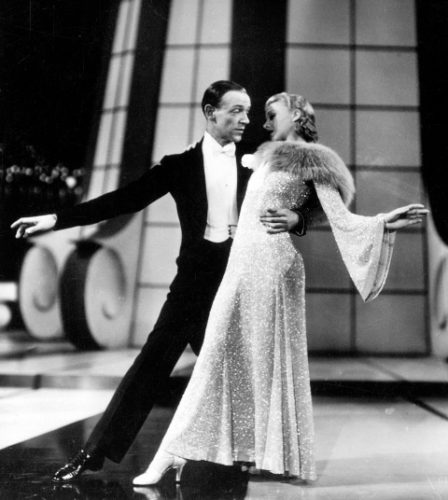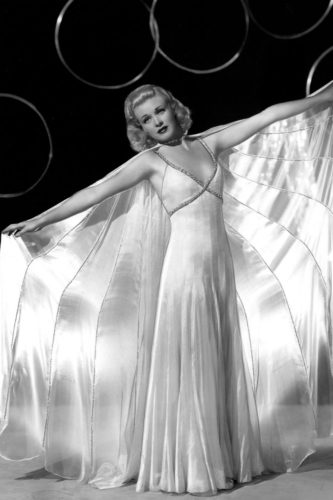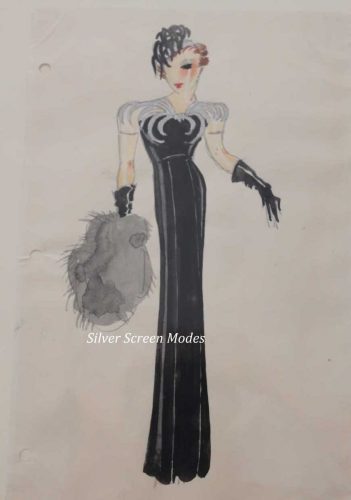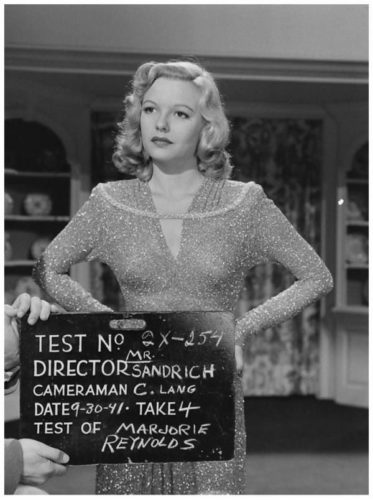Fred Astaire danced with the best dancing stars of classic Hollywood. And while they danced with him they were dressed by some of the best studio costume designers. His dance partners have included Ginger Rogers, who he danced with in several movies: Rita Hayworth; Eleanor Powell; Judy Garland; Vera-Ellen; Cyd Charisse, Leslie Caron; and Audrey Hepburn, and he even partnered with Gene Kelly in Ziegfeld Follies.

Fred Astaire was born to entertain. He and his older sister Adele began a Vaudeville act when he was 7. Fred met George Gershwin in 1916 and they remained friends for the rest of George’s short life. The Astaires were on Broadway by 1917. They performed in several musicals that took them to London. There, Adele was wooed and wed by Lord Charles Cavendish. Along with his natural grace Fred picked up the impeccable style of the British upper class. But now he was without a partner and his act fell apart. He managed to find himself in another successful Broadway musical, Gay Divorce (1932-1933), with dancing partner Clare Luce, with Cole Porter’s music including the catchy number, Night and Day. After closing the show he went to Hollywood with a contract at RKO Pictures.
David O. Selznick was the head of production at the time, with Pandro Berman a leading producer. Fred’s first screen test for the studio didn’t bring down the house. According to Fred Astaire’s later memory, it summarized him as, “Can’t act. Slightly bald. Also dances.” But all Fred needed was a dance partner. Yet RKO’s first role for him wasn’t ready so he was loaned out to MGM for a role starring as himself with a dance partner not quite up to the task: Joan Crawford, in Dancing Lady (1933). But lightning sparked when Fred was paired with Ginger Rogers in RKO’s Flying Down to Rio. Ironically, the future dancing dynamos were not even top-billed. The stars of the movie were Dolores Del Rio and Gene Raymond. Fred and Ginger had smaller parts, especially Ginger, but they smoked the floor when they danced to “The Carioca.” They stole the show, as they say in show business. Dolores Del Rio was a big star at the time and used her favorite designer Irene (Lentz Gibbins) to design her wardrobe for the film. Walter Plunkett was RKO’s costume designer and he designed Ginger Rogers’ costumes and those of the chorines.

RKO realized they had something special with Fred and Ginger, and when Broadway’s Gay Divorce was turned into RKO’s 1935 film The Gay Divorcee (a gay divorce could not possibly happen according to the censor), the studio realized they had gold. This movie musical launched something different: Fred insisted on the cameras shooting Ginger and him dancing full bodied cross the studio floor. No jump cuts or edits of close-up foot-work or head shots would be used until they were finished. Plus they smiled as they danced, looking like they were having the greatest time. Deep in the Depression, this was a winning combination for the audience. Fred’s early screen test meant nothing now, especially with his chemistry with Ginger Rogers. As someone said about the duo, “He gave her class and she gave him sex.”
Their dancing was infectious to look at, a symbol of the romance that was always bubbling as part of the plot. And a plot that became a standard with RKO’s Fred and Ginger movies. They meet seemingly by accident, and while there’s attraction, things go wrong and keep going wrong until they finally unite at the very end.
Walter Plunkett designed Gay Divorcee, and with his first two RKO movies he set the pattern for her dance dresses: a tight fit at the waist and bodice that showed off her gorgeous figure, and a flowing skirt that twirled as she danced with Fred.

Walter Plunkett’s costume sketch below shows the costume worn by the chorines (the white version, there was also a black). The ruffles at the elbows were brought up to the shoulders.

By the time Fred and Ginger’s third film Top Hat (1935) was being made, Walter Plunkett had left RKO due to a salary dispute. New York fashion designer Bernard Newman had been brought on and was given the choice assignments and that didn’t please Walter. But Newman’s designs for Ginger became more eye-popping, and she became more involved in the designs. Newman’s famous light blue “Feathers” gown for Top Hat was a good example. It was made of silk satin with ostrich feathers at the skirt and shoulders. It became a bit of a battle between the Astaire camp and the Rogers camp as to whether it would remain in the movie. The issue, unresolved to the end, was how to keep the feathers from coming loose when Ginger danced with Fred. Even after some hand-re-sewing of individual ostrich plumes, they can still be seen flying about in the “Dancing Cheek-to-Cheek” number, which irritated Fred to no end. But what a magnificent scene. My great-aunt was irritated too. As the head cutter-fitter at RKO wardrobe, she didn’t have to do the sewing, but she had to supervise the process. Fred made light of the whole matter afterwards. He made a present to Ginger of a gold feather for her charm bracelet.

Follow the Fleet followed Top Hat, and Bernard Newman followed his knock-out gown for Ginger with another one. The stellar gown in this movie was made entirely of silver bugle beads, trimmed with a fox collar. The gown weighed about 30 lbs. The bugle beaded skirt was translucent so you could see her figure against the light. But once again, Fred was not happy. The bell-shaped sleeves were heavy too, and when she twirled around in early takes her sleeves would slap up against his cheeks. But again, the resulting “Let’s Face the Music and Dance” Irving Berlin number has to be their most beautiful (below). It was shot in one take.

Swing Time followed, which many consider the best of the Fred and Ginger movies (though closely matched by Top Hat). Bernard Newman again designed Ginger’s wardrobe although there were no over the top gowns. At this point she didn’t need them to get noticed in a movie, as all eyes were frequently on her. The usual plot-line of the rough meeting, sudden attraction, then roller coaster road to a relationship is laid out again. And there are the dances – always sublime.

When they first meet, Ginger is a dance instructor and Fred pretends not to know how to dance (at first). For the scene she wears a simple black dress with white pleated Peter Pan collar with bow. The full pleated skirt is designed to flow as she dances.

The climactic dance is the “Never Gonna Dance” number, Jerome Kern and Dorothy Field’s song written for the movie. Bernard Newman’s design for Ginger was a beautiful flowing backless décolleté gown with criss-cross straps decorated with rhinestones. This gown too is translucent, as was the detachable cape. The dance number was the highlight of their partnership.

Fred and Ginger made Shall We Dance in 1937 and Carefree in 1938 but their movies weren’t as popular as before. America was slowly coming out of the Depression and movie audience expectations were changing. A theater magazine had just listed several actors as “Box office poison,” and among them were big stars like Greta Garbo, Joan Crawford, Katharine Hepburn, Marlene Dietrich, and Fred Astaire. Bernard Newman had just left RKO. While his designs were stunning, he couldn’t keep up with the pace of work at a Hollywood studio. Howard Greer, formerly of Paramount Pictures filled in to design Ginger’s wardrobe for Carefree. He had opened his own fashion business in Beverly Hills and was doing rather well. After he finished this film Edward Stevenson, with years of experience going back to First National, assumed most of the design duties at RKO. A Howard Greer costume sketch for Ginger in Carefree is shown below. Fred and Ginger’s final movie at RKO was The Story of Vernon and Irene Castle. As the studio wanted, this would be a departure from their usual boy meets girl, boy loses girl, boy gets girl back story. It was based on the real story of the once very famous dance team of the Castles. But problems began early. Vernon had already died and Irene wanted the movie to be very exact in its portrayal of them – down to story line, dance steps, costumes, and their likeness. It’s still a mystery who designed the costumes. Walter Plunkett, who had come back to RKO, stated he bowed out when Irene Castle became so rigid in her demands. The costume sketches themselves are unlike any done by the regular sketch artists at RKO. In any event, the movie was not a success and while Ginger stayed on at RKO to win an Oscar for Kitty Foyle, Fred’s contract was up and he moved on.

Fred was not quite the box office poison the article made him out to be. MGM, Paramount, and Columbia all wanted him to do movies for them. MGM came in first with Broadway Melody of 1940, made in 1939, which was followed later by a long term contract. In this movie he more than met his match in tap -dancing: the incredible Eleanor Powell. When the two danced in the Begin the Beguine number, it was introduced years later by Frank Sinatra for That’s Entertainment! He stated, “You can wait around and hope, but you’ll never see the likes of this again.” But In the photo below, they dance in Eleanor’s favorite, the “Jukebox” tap dance number. They are both having fun with this one.
The costume designer for this film was Adrian, and while all Eleanor’s costumes move well while she dances ( and they don’t bother Fred) he adds whimsy with the Cossack accents.

Fred moved to Paramount Pictures where in 1942 he made what would become a classic, Holiday Inn (along with it’s sequel) , or as it was fully titled: Irving Berlin’s Holiday Inn. Here he was joined by Bing Crosby and Marjorie Reynolds. And while Fred dances Marjorie Reynolds around the floor (at one point on the floor when he plays drunk), it’s when Bing sings “White Christmas” to Marjorie, and then they sing in duo, that music history is made.
Edith Head designed Marjorie Reynolds’ costumes. Allthough the movie was black and white one of the costumes was made of gold beads. The costume sketch below (shown with Fred as the dance partner) was modified somewhat in the film as an embroidered silk gown. The signature on the sketch is that of director Mark Sandrich.

The photo below shows Marjorie in her gold beaded gown.

Fred made a couple of movies at Columbia Pictures after talking to producer Gene Markey. He would star with the daughter of an old dancing Vaudeville friend of his, Eduardo Cansino. His daughter was Rita Cansino, now known as Rita Hayworth. Their first movie together was successful: You’ll Never Get Rich (1941) , but their second movie You Were Never Lovelier (1942) was a hit. The music was by Jerome Kern and Johnnie Mercer. Here Fred courts Rita, but her Argentine father disapproves.

The photos above and below show Fred and Rita dancing in You Were Never Lovelier. Rita’s beautiful wardrobe was designed by Irene (Lentz Gibbons), who was designing for Bulluck’s Wilshire at the time. Irene frequently freelanced for studio work for stars that demanded her services, as she had for Dolores Del Rio. This gown had embroidered sequins at the bodice and skirt, with an illusion top. It flowed beautifully as can be seen in the bottom photo. Unfortunately, while Fred sang the “You Were Never Lovelier” song to Rita, the dance scene was cut from the final film.

Fred Astaire had achieved an enviable career in his first decade in Hollywood. But much more was yet to come. More of his films, dance partners, and their costumes is covered in Part II of this blog here
Views: 10397
